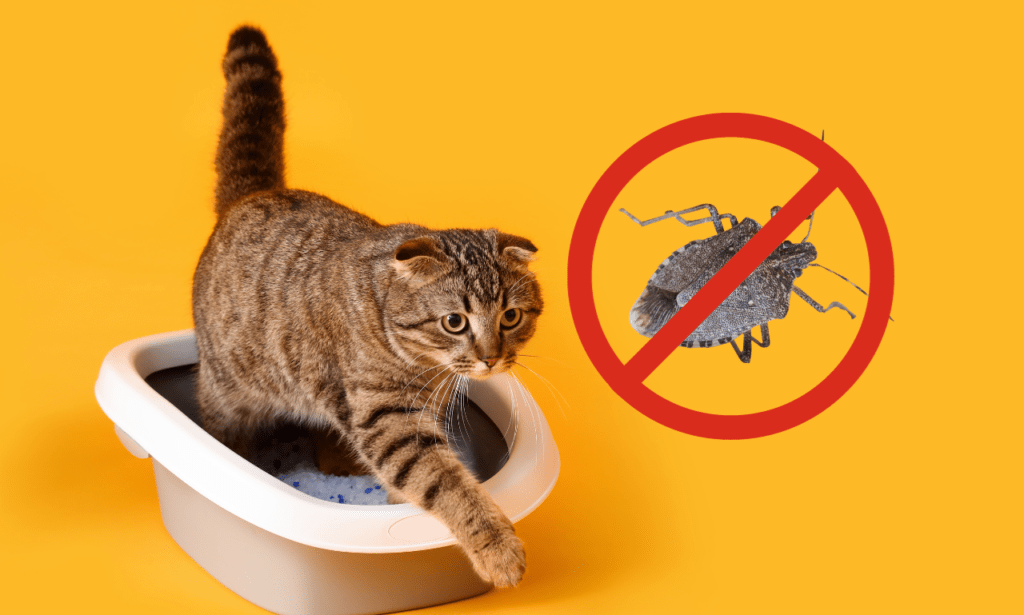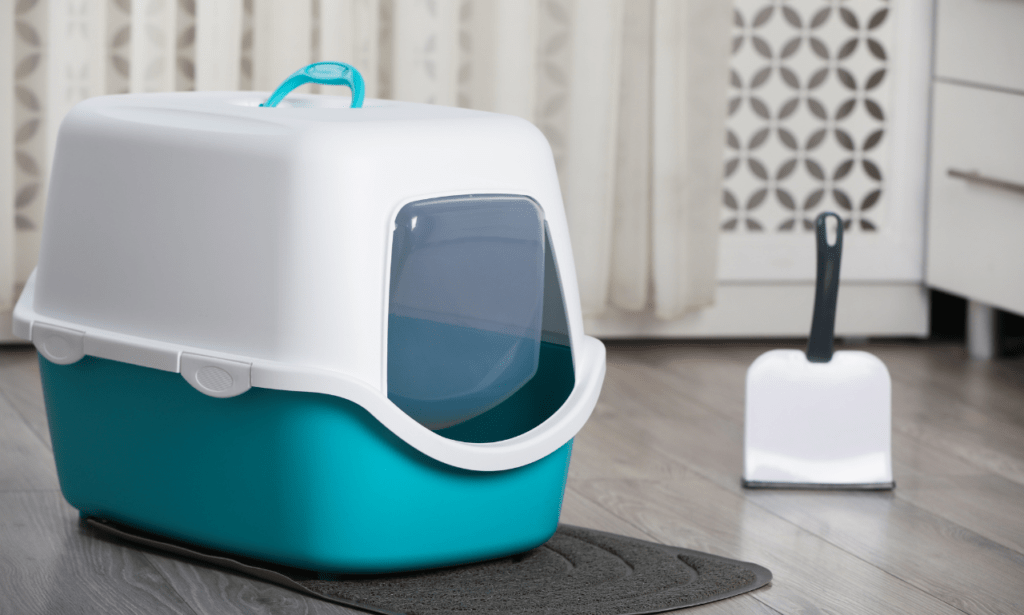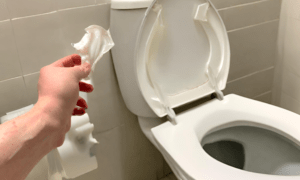Introduction
Understanding the Problem: Bugs in the Litter Box
Bugs in your cat’s litter box can be a troubling issue. It’s essential to address this problem promptly to ensure your cat’s hygiene and prevent potential health risks. This comprehensive guide will equip you with the knowledge and strategies needed to tackle bugs in the litter box effectively.
The Impact of Bug Infestations on Your Cat and Home
Bug infestations in the litter box not only affect your cat’s comfort but also pose health concerns for your entire household. We’ll explore how these infestations can impact your cat’s well-being and the steps you can take to create a clean and pest-free environment.

Identifying Common Litter Box Pests
Types of Bugs That Can Infest a Litter Box
Litter box bugs come in various forms, from tiny mites to beetles and flies. We’ll provide an overview of the most common types of pests that can infest your cat’s litter box. Understanding these pests is essential for effective identification and treatment.
- Mites: Mites are microscopic creatures that can easily infest your cat’s litter box. These tiny pests thrive in warm and humid environments, making litter boxes an ideal breeding ground. Mites can irritate your cat’s skin and cause discomfort, so it’s crucial to address them promptly.
- Fleas: Fleas are not just a problem for your cat; they can also infest the litter box. These blood-sucking insects can jump from your cat onto the litter and lay their eggs there. Controlling fleas is essential for your cat’s health and for preventing an infestation in the litter box.
- Flies: Flies are attracted to the odor of cat waste, and they may lay their eggs in or around the litter box. This can lead to a maggot infestation, which is not only unpleasant but also unhygienic. Proper sanitation and covering the litter box can help deter flies.
- Beetles: Certain types of beetles, such as dermestid beetles, are known to infest cat litter boxes. They are often drawn to the organic matter in the litter, including cat feces. These beetles can multiply rapidly and may become a nuisance if not dealt with promptly.
- Ants: Ants are resourceful insects that can invade your cat’s litter box in search of food. They can disrupt your cat’s routine and create unsanitary conditions. Addressing ant infestations may involve both eliminating the pests and keeping the litter area clean.
- Cockroaches: In some cases, cockroaches can infest litter boxes, especially if there are food particles or crumbs nearby. Cockroaches are not only unpleasant to have around but can also carry diseases, making it essential to keep the litter area clean and free of any potential food sources.
- Earwigs: Earwigs are nocturnal insects that may take up residence in a litter box. While they are generally harmless to cats, their presence can be unsettling. Ensuring the litter box is in a clean and dry environment can help deter earwigs.
- Silverfish: Silverfish are known for their love of moisture and starch, which can sometimes lead them to infest cat litter. These pests are more common in areas with high humidity, so controlling the humidity around the litter box can be an effective preventive measure.
Recognizing the Signs of Bug Infestations
To address the issue, it’s crucial to recognize the signs of bug infestations. Early detection allows for quicker intervention, reducing the impact on your cat’s hygiene. These unwanted critters can easily infiltrate your cat’s litter box, causing discomfort for your feline friend and potential health hazards. Here, we’ll delve into the telltale signs that may indicate a bug problem in your cat’s litter box.
- Unusual Agitation: One of the initial signs of a bug infestation in your cat’s litter box is unusual agitation or reluctance to use it. Cats are known for their cleanliness, and if they suddenly start avoiding their litter box or seem distressed while using it, it could be a sign that bugs are bothering them.
- Visible Insects: Sometimes, the most apparent sign of a bug infestation is the presence of actual insects in the litter box. Common intruders include ants, fleas, or flies. If you notice these critters in or around the litter box, it’s a clear indication of a bug problem.
- Altered Litter Behavior: Pay attention to any changes in your cat’s litter box behavior. If your cat begins to dig excessively or seems to be scratching the litter aggressively, it may be an attempt to ward off bugs. This behavior can result from the discomfort of having bugs in their territory.
- Strange Odors: Bug infestations can bring with them unpleasant odors. If you notice a foul or unusual smell emanating from the litter box area, it could be a result of insects or their waste. These odors are not only unpleasant for your cat but also indicate a hygiene concern.
- Excessive Grooming: Cats are known for grooming themselves regularly, but if you observe your cat engaging in excessive grooming, especially around their hindquarters, it might be an attempt to rid themselves of bug bites or irritations caused by insects in the litter.
- Visible Signs of Bites or Irritations: Check your cat’s skin for any visible signs of bug bites or irritations. Redness, swelling, or small sores can be indicators that your cat is dealing with insect-related issues, often associated with their litter box.
- Dark Specks in Litter: Inspect the litter itself for any dark specks or tiny particles that resemble insect feces or exoskeletons. These can be a clear sign that bugs are present and using the litter box as a nesting or feeding ground.
- Increased Scratching or Pawing at the Box: Cats may respond to bug infestations by scratching or pawing at the sides or bottom of the litter box. This behavior can be an attempt to unearth or deter insects from their preferred hiding spots.

Why Do Bugs Invade Litter Boxes?
Exploring the Attractants and Causes
Understanding why bugs are drawn to litter boxes is essential for avoiding infestations. Bug attractants and causes, such as the smell of waste, moisture, and organic materials Gaining insight into these factors helps you address the root causes.
Understanding How to Break the Cycle
Breaking the cycle of bug infestations involves addressing the factors that attract and sustain them. We’ll provide practical guidance on how to disrupt the breeding and feeding habits of litter box bugs, ensuring a bug-free environment for your cat.

Prevention: Keeping Bugs Out of the Litter Box
Effective Strategies for Preventing Infestations
Preventing bug infestations in your cat’s litter box is essential for maintaining a clean and healthy environment for both your pet and your household. To achieve this, we’ll delve into a range of effective prevention strategies, each designed to keep pesky bugs at bay.
Choosing the Right Litter and Placement
The choice of litter and the location of the litter box play pivotal roles in bug prevention. Selecting the right type of litter that discourages bugs is the first step. You should also consider where to place the litter box to minimize the chances of infestation. Opt for well-ventilated, dry areas and avoid dark, damp corners that are more attractive to insects.

Home Remedies for Eliminating Litter Box Bugs
Safe and Natural Solutions to Address Bug Infestations
Discovering bugs in your cat’s litter box can be unsettling, but there are safe and natural remedies you can employ to combat them. We’ll explore a variety of options, including the use of diatomaceous earth, essential oils, and simple yet effective cleaning routines. These methods not only eliminate bugs but also ensure your cat’s well-being.
Step-by-Step Guide to Clearing Your Litter Box
Step 1: Gather Your Supplies Before you begin the process of clearing your litter box of bugs, it’s essential to gather all the necessary supplies. You’ll need rubber gloves, a face mask, a large garbage bag, a scrub brush, mild dish soap, warm water, a plastic container with a lid, and a fresh supply of cat litter. These supplies will ensure you can effectively and safely address the infestation without putting yourself or your cat at risk.
Step 2: Isolate Your Cat For your cat’s safety and comfort during the cleaning process, it’s crucial to isolate them from the affected area. Place your cat in a separate room with their food, water, and a clean litter box. This step ensures that your cat remains unaffected by the bug-infested environment and minimizes their stress during the cleaning process.
Step 3: Empty and Dispose of the Old Litter Carefully scoop out all the old litter from the bug-infested litter box, placing it in a sealed plastic bag. Make sure to double-bag the litter to prevent any bugs from escaping and dispose of it in an outdoor trash bin. This step eliminates the primary source of the infestation and prevents bugs from continuing to breed in the litter.
Step 4: Clean and Disinfect the Litter Box Thoroughly clean the litter box using warm, soapy water and a scrub brush. Rinse it well to remove all soap residue, as cats can be sensitive to certain cleaning agents. After rinsing, disinfect the litter box with a pet-safe disinfectant or a mixture of white vinegar and water. Ensure that it is completely dry before adding fresh litter to prevent moisture that may attract bugs.
Step 5: Treat Bug-Infested Areas Inspect the surrounding area for any signs of bugs, such as fleas or ants. If you find bug-infested areas near the litter box, treat them accordingly. Use pet-safe insecticides or natural remedies like diatomaceous earth to eliminate bugs. Make sure to follow the product’s instructions carefully and keep your cat away from treated areas until it’s safe.
Step 6: Create a Bug-Resistant Environment To prevent future bug infestations, maintain a clean and hygienic environment around your cat’s litter box. Store cat food in airtight containers, regularly clean the litter box, and vacuum the surrounding area to remove any crumbs or debris that may attract bugs. Additionally, consider using a flea collar or monthly flea prevention for your cat to further deter infestations.
Step 7: Monitor and Maintain Continue to monitor the litter box area for any signs of bugs. If you notice any resurgence of the infestation, repeat the cleaning and treatment process. Consistent maintenance and vigilance will help ensure a bug-free space for your feline friend.

When to Seek Professional Pest Control
Signs That Bug Infestations Require Expert Intervention
While home remedies are often effective, some bug infestations may persist or worsen, necessitating the involvement of professional pest control services. We’ll discuss the signs that indicate it’s time to seek expert help, such as unrelenting infestations or the presence of more resistant pests.
How Pest Control Services Can Safeguard Your Home
Professional pest control experts possess the knowledge and specialized tools required to tackle bug infestations effectively. They can do so while ensuring the health and comfort of your cat and family members. We’ll explore the benefits of their intervention in resolving persistent bug problems and restoring peace to your home.

Maintaining a Bug-Free Litter Box
Ongoing Maintenance Tips for Preventing Recurrences
Once you’ve addressed a bug infestation, it’s crucial to maintain a bug-free litter box environment. We’ll provide you with ongoing maintenance tips, including establishing regular cleaning routines, closely monitoring for any signs of bugs, and implementing preventive measures to ensure a consistently bug-free environment.
Creating a Hygienic Litter Box Environment
A clean litter box is essential for your cat’s overall health. To create a comfortable and pest-free environment that promotes your cat’s health and happiness, cleanliness, proper litter selection, and regular maintenance are required.

Cat Health and Hygiene Considerations
The Importance of Your Cat’s Well-being
Maintaining your cat’s health and well-being is paramount when dealing with litter box bug issues. Regular veterinary check-ups, closely monitoring your cat’s behavior for any changes, and addressing any health concerns promptly will ensure your cat remains happy and healthy.
Ensuring Your Cat’s Comfort and Safety
A bug-free litter box is crucial for your cat’s comfort and safety. Creating a welcoming and stress-free litter box environment ensures that your feline companion feels secure and content and that their litter box experience remains positive.
Ensuring the Health and Safety of Your Cat During Pest Control
Should you need professional pest control services, it’s vital to prioritize your cat’s health and safety throughout the process. We’ll discuss safety precautions, including temporary relocation options for your cat, to minimize any potential risks and ensure their well-being.
Safe Practices for Combating Litter Box Bugs
Whether you’re using home remedies or seeking professional help, maintaining safe practices for combating litter box bugs is essential. Your cat’s well-being should always remain a top priority throughout the bug elimination process..
Conclusion
In conclusion, this comprehensive guide has equipped cat owners with the knowledge and tools needed to effectively address bug infestations in the litter box. By identifying common pests, implementing prevention strategies, using safe home remedies, and recognizing when to seek professional assistance, you can ensure a clean and comfortable litter box environment for your beloved feline companion.
A Healthy and Pest-Free Environment for You and Your Cat
The ultimate goal is to provide your cat with a healthy, pest-free environment where they can thrive. By following the advice provided in this guide, you can create a litter box space that is free from bugs and conducive to your cat’s well-being. This not only enhances your cat’s quality of life but also contributes to a harmonious and enjoyable living environment for both you and your cherished feline friend.
If you’re looking to learn more about keeping unwanted visitors out of your garage, don’t miss our comprehensive guide on “How to Keep Lizards Out of Your Garage.“















